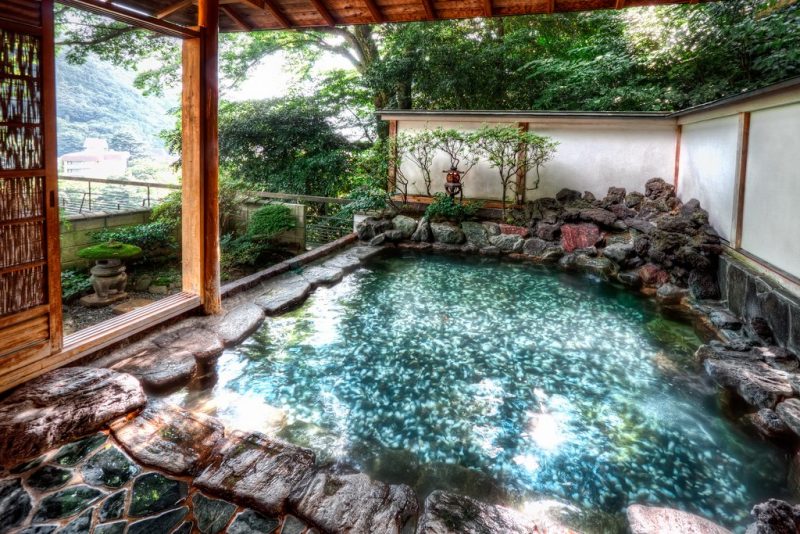Jan 29, 2021
Take a Soothing Soak at one of Hiroshima’s Super Hot Spring Spas
As temperatures around the country plummet, the Japanese winter can seem harsh, particularly if you are not fortunate enough to live in an environment that is equipped with central heating. However, as unlikely as it seems, there is some cause for celebration, as the winter is the perfect time to indulge in the Japanese pastime of onsen.
What is ‘onsen’?
An onsen is probably best described as a hot spring bathing spa, and their use is a long-held tradition in Japan. While it may seem unpleasant to live in a nation of constantly shifting tectonic plates, the pay off is a near-endless supply of geothermal springs in which the locals love to bathe. Though traditionally located outdoors, there are nowadays many indoor bathing spots throughout Japan for you to enjoy.
(NB: These indoor onsens, heated by water from natural geothermal springs, should not be confused with sento. Onsen must legally contain at least one of 19 designated chemical elements, including iron, sulfur, and metabolic acid, while the artificially warmed sento public baths do not).
While many of the more famous onsens can be found in Japan’s more mountainous regions (more about which you can read here), Hiroshima still abounds with some fantastic hot spring spas. Here are a few of the best-regarded spots in the region.
Yu-no-Yama
According to some sources, the hot springs at Yu-no-Yama [Hot Water Mountain] go back some 1200 years. Of course, these sorts of claims can be taken with a pinch of salt, but what is actually documented is that the springs here were built up and enjoyed by the local Daimyo [cheiftan] Yoshinaga Asano in around 1750.

Today it remains one of the region’s most popular onsen, with good reason. Like much of the region, the water contains trace elements of radon, which they claim has healing qualities rather than the dangers posed by higher quantities. According to local wisdom, the healing properties are at their best when cooler, which is why one of Yu-no-Yama attractions is the ‘utase-yu,’ where you bathe with lukewarm water cascading from the mountain, creating an invigorating massage effect. It’s an experience at the very least. There are a few baths in the area, but Yuki Lodge is possibly the best of them.
Where: Oaza-wada, Yuki-Cho, Saeki-Ku, Hiroshima (map
Miyahama Onsen
Though half an hour’s drive down the coast from Hiroshima’s city center, Hatsukaichi is a quiet spa town with just a handful of ryokan [Japanese hotel or inn] on the hillside serving the Miyahama’s onsen. However, from each of these, you should be permitted stunning views of Miyajima Island across the bay as well as the peaceful undulations of the Seto Sea, with many baths situated to take advantage of the spectacular visage.

As well as the scenery, being located so close to the shoreline, the seafood served up in this area is as fresh as you’ll find, and while it isn’t the cheapest way of spending your days (and nights, should you so choose) it certainly is a fantastic way to do so.
Where: 2 Chome-2-1 Miyahamaonsen, Hatsukaichi, Hiroshima (map)
Nukui Springs
The nutrients found in spa water are said to cure various ailments, and the type of water in which you bathe is said to have differing curative properties. The water found in the Nukui springs area, coming from a cold source with trace radium elements, is believed to assist with nerve irritation, high blood pressure, and sensitivity to cold and digestive problems.

The Nukui Springs Hotel was built in 1992 upon the spectacular Ryuki Lake’s shores, formed by the dramatic Nukui Dam. Its location, nestling into the gorgeous mountainside, enhances the relaxing atmosphere, and as you soak in your outdoor bath, you can breathe in the oxygen-rich air of the forests that surround you.
Where: 4692-7 Kake, Akiota, Yamagata District, Hiroshima (map)
Miyajima
Miyajima Island has plenty for tourists to see and do (and you can read more about that here), but after a long day of wandering trails, visiting temples, feasting on oysters, and feeding deer, you may feel like you require a little rest.

Fortunately, there are many public-access onsens in the area in which you can soak your cares away. Miyajima Villa’s ‘Yu Like’ onsen has panoramic views from where you can gaze out at the beautiful sunset, while at Live Max Resort, there are many baths – one of which offers views of the floating torii gate – and a sauna. Kinsuikan’s 100 percent natural springs combine with seawater to add to the healing qualities. Using the salt rub before entering the waters, you will feel even more purified, ideal for visiting shrines and temples.
Where: Miyajimacho, Hatsukaichi, Hiroshima (map)
Image: via Wikipedia [CC BY-SA 4.0], via Wikimedia Commons
Image: via https://www.yuki-lodge.jp/en/yunoyamaonsenkan.html
Image: via https://miyahama.com/en/bath/
Image: via http://www.nukui-sp.com/english/springs.php
Image: via https://miyajima-villa.jp/en/spa


About the author